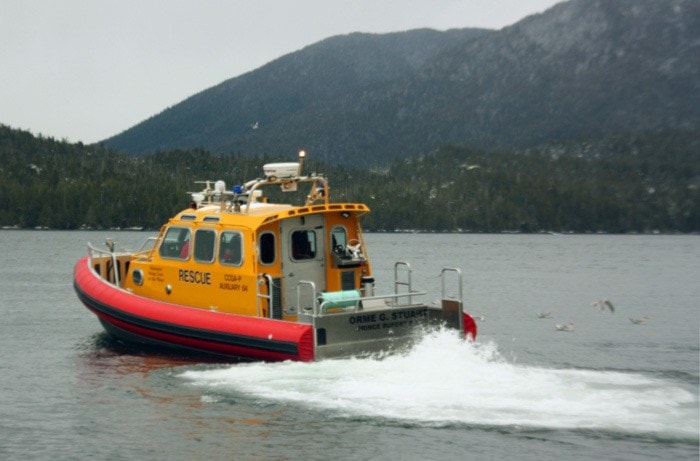The Coast Guard Auxiliary was showing off it's new rescue boat that they purchased in-full after an extensive fundraising campaign in Prince Rupert.
The new boat named the Orme G. Stewart is a state-of-the-art rescue vessel that cost over half a million dollars, all of which was fundraised locally including substantial donations from organizations like the Port Authority and Rotary Club.
The new boat is a big improvement in many ways. Besides being bigger, the new boat is designed to be able to roll back over if flipped in rough seas, inside the cabin there are shock-absorbing seats, all the latest navigational equipment a bench-seat that can be converted into a place for a stretcher -- complete with a locking mechanism for holding it in place. Inside the bow of the boat is more space for people and equipment.
One of the most important new features of the boat is the $60,000 robotic thermal camera that can pan 360 degrees around the ship looking for survivors in the ocean. It's the only one of its kind on the North Coast, the closest other boat equipped with one is in Nanaimo.
“It can pick up the heat from somebody's head in the water from six miles away,” boasts the Coast Guard Auxiliary's unit leader, Marko Kessler.
This will be a big improvement for rescuers when looking for someone in the cold North Coast waters. Before the camera, looking for someone at night meant using searchlights. One member of the unit says that even during training exercises they usually can't see the target until they're very close to it, and that's when its a brightly coloured ball and not a human head.
The consequence is that survivors will often see the rescue boat from almost three miles away but rescuers can't see them. The thermal camera changes that.
Another big feature of the boat is that it uses water jets instead of propellors. There are a couple of practical upshots to this.
Firstly, it means that the crew doesn't need to worry as much about objects in the water. The reinforced keel of the boat will be able to hit a floating log without risking damage to a propellor. It also means that the vessel can be used in only four feet of water and can be safely beached.
The second big advantage of the jets is manuverability. The jets can be directed independently of one another which allows the ship to make very tight turns and even to spin around around in one spot without moving forward. Something that the crew were all too happy to demonstrate for the media.
The Orme G. Stuart won't be ready for actual duty until around April. All the glitches and bugs need to be worked out of the boats systems, and the crew will need time to get acquainted with all the modern equipment inside. The crew also has to be re-certified by the Coast Guard Auxillery to use the jet-powered boat instead of a propellor-driven vessel.
“There's more maintenance with this vessel. There's much more to look at in terms of what can go wrong with the engines and jets. Basically, there's a different skill for this vessel; it's a different size being quite a bit larger, when your at the helm there's more electronics, there's things like the infrared camera, there's more options for situations like a man-overboard. How we deal with stretchers and basic transfers because now we have room for stretchers. There's lots to learn,” says another auxiliary member Shawn Petriw.
While the boat might not be ready for rescue missions, it has already been given an intense test-drive. The boat was bought from Titan Boats in Sydney and had to be sailed up to Prince Rupert from Vancouver Island. On its maiden voyage to its new home, the boat encountered rough seas, a storm, floating logs and even had to sail to Hartley Bay while sailing in zero-visibility conditions. And it still made it to Prince Rupert without too much trouble.
